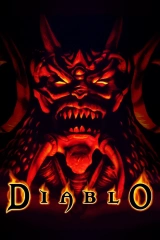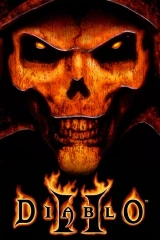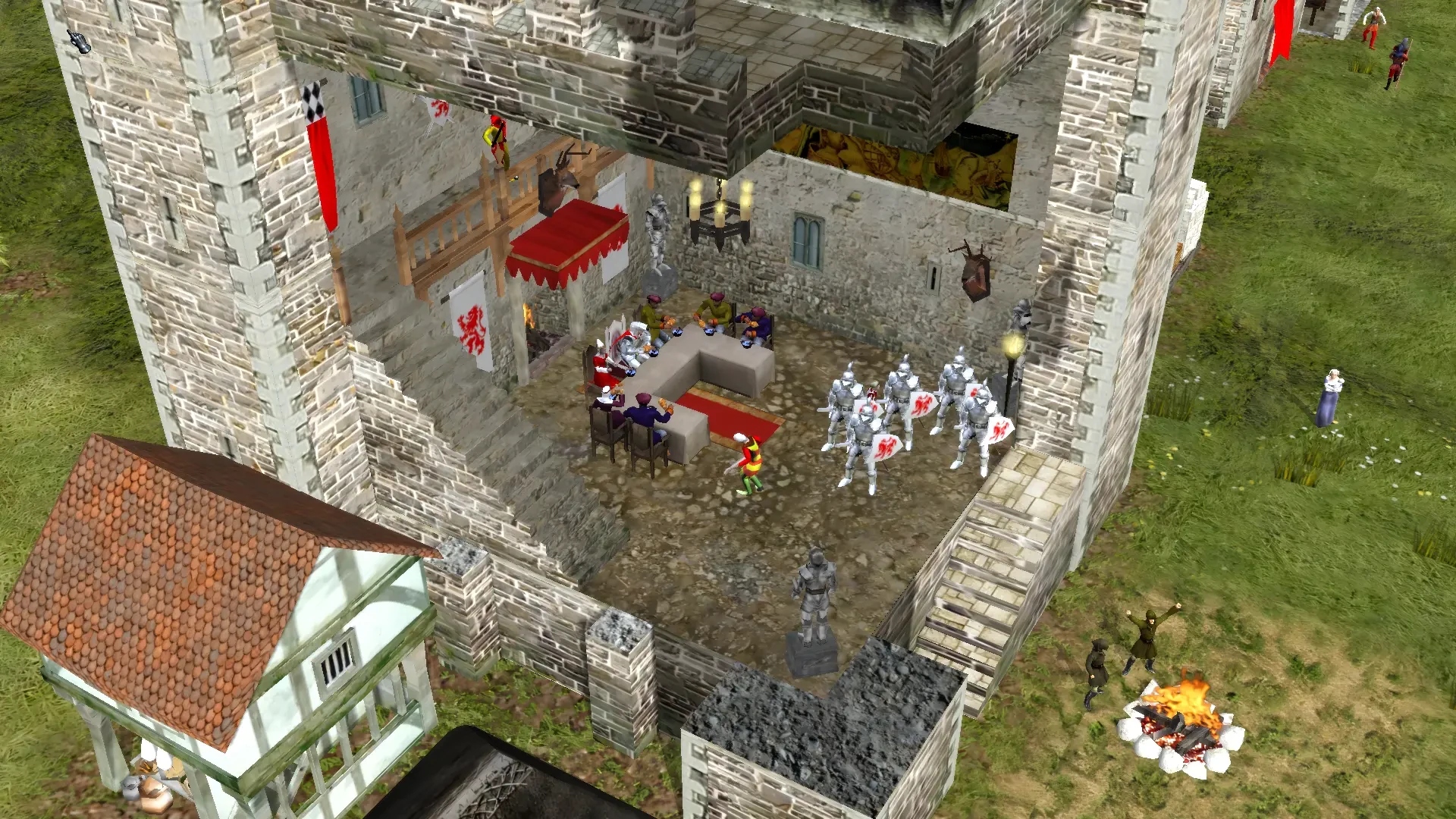
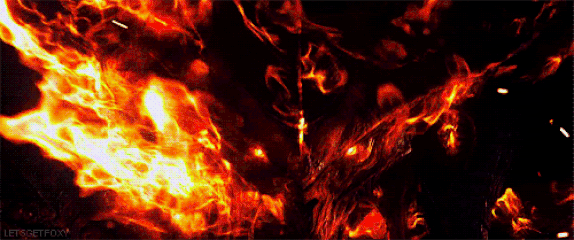
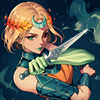
Diablo: The Hell 2
Мод для Diablo (1996) | Категорія: Повні переробки
Автор: Mordor_XP | Куратор: Modbadger
Мод для Diablo (1996) | Категорія: Повні переробки
Автор: Mordor_XP | Куратор: Modbadger
Diablo: The Hell 2 — хардкорний мод для оригінального Diablo, який продовжує ідеї The Hell 1. Повністю перероблений з нуля, він додає нові класи, заклинання, сотні предметів і ворогів, покращує баланс, механіку та графіку, підтримує сучасні системи та мультиплеєр.
Локалізації:

Локалізації:
Мод локалізований на 1 мову
(Вам не потрібно нічого додатково завантажувати, щоб грати цими мовами)
Особливості:
Якість, стабільність, баланс і реіграбельність — головні пріоритети.
Заснований на Hellfire, мод додає щонайменше на 50% більше контенту: 24 основні рівні підземель і 21 новий квестовий рівень для одиночної гри. Перемога над Diablo на 16-му рівні не завершує гру — далі на вас чекають сходи вниз, що ведуть до невідомих глибин із більшими викликами та нагородами.
Оновлений рушій із підтримкою налаштовуваних роздільностей до 4K, широкоформатним режимом, віконним і безрамковим віконним режимом, повноекранним режимом і миттєвим перемиканням (Alt + Enter), а також налаштовуваною частотою кадрів від 20 до 10 000 fps.
Робочий мультиплеєр через RadminVPN: інстансовий та розділений лут, автоматичний підбір золота, біг у підземеллях, динамічна складність, що підлаштовується під кількість гравців. Важливо: для підключення у всіх гравців має бути однакова версія мода.
Виправлено всі ключові баги оригінальної Diablo 1.
Безліч нового контенту й оновлений геймплей: предмети (базові, класові, рідкісні, зачаровані, унікальні та набори), монстри (звичайні, чемпіони, спеціальні, унікальні, сюжетні), заклинання, святині, нові кольори монстрів і рівнів, покращений ШІ.
Похмура атмосфера гри, ще більш диявольська, ніж в оригіналі.
Шість основних класів і 29 підкласів з унікальними ігровими особливостями: дворукі, лучники зі стрільбою серіями та снайпери, критери, суммонери, трапери, кидальники пляшок, регенератори, блокувальники, танки, збірки з аурою, збірки без предметів і багато іншого.
Широкі можливості налаштування геймплею під індивідуальні вподобання.
Вісім режимів гри на вибір: Easy, Normal, Hard, Hardcore, Ironman, Soft Iron, Speedrun і Nightmare.
Три нові слоти для предметів: рукавиці, чоботи та пояси, а також три слоти для зброї з можливістю перемикання між ними.
Розширений інвентар — 10x7 клітинок замість звичних 10x4.
Безліч нових зручних функцій і унікальних ігрових механік для покращення якості життя.
Відновлено квести, що не увійшли до оригінальної Diablo, з унікальними налаштуваннями рівнів (лід, отрута, кров) і особливостями локацій (уповільнення атак і заклять, штрафи, модифікатори регенерації, обмеження на заклинання та інші ускладнення).
Ремастер музики в Hi-Fi стерео — оригінальна музика Diablo була монофонічною! TH2 пропонує якісніше звучання, стерео й великий вибір треків для підземель загальною тривалістю понад 3 години (в оригіналі — близько 32 хвилин).
Перки та синергії: підвищуючи рівень, ви отримуєте не лише характеристики, а й очки перків для розвитку персонажа й створення унікальних збірок. Синергії об’єднують ефекти кількох перків, підсилюючи їх.
Риси та ігрові зміни: стартові персонажі можуть обрати до двох унікальних рис, які впливають на геймплей. Ігрові зміни не обмежені в кількості й працюють у зв’язці з рисами, забезпечуючи величезну варіативність збірок.
Розширені налаштовувані гарячі клавіші: тепер можна призначати уміння не лише на F5-F8, а й на літери A-Z, включаючи швидке застосування заклять при натисканні кнопки.
Крафт і зачарування: Адрія та Грізвольд можуть покращувати ваші предмети, додаючи їм гнізда й нові магічні ефекти.
Важливо! The Hell 2 може бути дуже захоплюючою грою, тому не рекомендується проводити за нею занадто багато часу поспіль. Обмежуйте час гри, щоб уникнути емоційного перенапруження. За багаторічними спостереженнями встановлено, що тривала гра на високих рівнях складності може викликати стрес. Оптимальна тривалість — близько 3–4 годин на день. Деякі гравці грають по 12 і більше годин на добу протягом місяців, що часто призводить до емоційного вигорання. Якщо ви відчуваєте зростаюче роздратування чи втому, зробіть перерву, займіться чимось іншим або переключіться на іншу гру. Не забувайте відпочивати, правильно харчуватися та добре спати. Розробники цінують своїх гравців і дбають про ваше здоров’я — воно важливіше за будь-яку гру.
Основні особливості The Hell 2, які варто знати для максимального задоволення від гри.
У основі гри лежить класична Diablo, але є багато змін, які роблять мод унікальним і більш цікавим.
"Біг" — за замовчуванням ваш персонаж може бігати поза боєм, як у місті, так і в підземеллях. Якщо хочете, цю функцію можна вимкнути — у налаштуваннях поставте JOG у положення off або повністю деактивуйте біг через конфіг.
"Режим бою" — коли ви активуєте монстра, гра переводить вас у бойовий режим. Поки ви у бою, бігати не можна. Вийти з бою можливо, лише якщо поруч немає активних монстрів на вашому рівні. Це правило діє як в одиночній, так і в багатокористувацькій грі, але в одиночці є додаткове обмеження...
"Блокування" (вона ж "Vise") — не дозволяє покинути поточний рівень і увійти у портал міста, доки не завершиться бій. Щоб зняти блокування і вийти з бою, потрібно або відійти від монстрів, або знищити їх. Під час битв з босами блокування тримається до їх смерті або вашої загибелі за сценарієм. Виняток — режим складності EASY, де блокування не застосовується.
"Wise Drops 2.0" — нова й удосконалена система випадання і фільтрації лута з The Hell 1. Тепер у грі більше класів, і в кожного свій набір специфічних предметів. Ви отримуєте лише те, що дійсно можете використовувати, враховуючи характеристики персонажа. Зброя тепер має 4 показники шкоди замість двох, а для кожного базового предмета розкид шкоди індивідуальний. Броня має вбудовані значення DFE (шкода від ворогів), броню, опору від шкоди ближнього бою і стріл, а також їх варіації. Деякі предмети генерують афікси — звичайні, бойові, викликаючі, шипи та магічні — корисні саме вашому класу.
"Перки" — важливе доповнення, яке дається при підвищенні рівня: одне очко перка на рівень, всього 49. Перки мають вимоги і частково залежать від обраного класу. У кожного перка кілька рівнів і описів. За кожні 10 очок перків ви приблизно отримуєте еквівалент одного предмета із силою афіксів. До 50 рівня це майже дорівнює додатковим 4–5 предметам. Скидання перків у грі немає і не планується.
Черті — при створенні персонажа ви можете вибрати до двох черт, які нададуть йому унікальність. Черті не просто посилюють персонажа — вони мають дві сторони: бонуси і штрафи. Наприклад, +CLVL% до магічної шкоди і -CLVL до класу броні (CLVL — рівень персонажа). Обрані черти залишаються назавжди, тому думайте уважно.
Геймченджери — це другий рівень тонкого налаштування персонажа при створенні. Їх кількість не обмежена, і вони можуть комбінуватися між собою, крім взаємовиключних варіантів — такі просто не можна вибрати одночасно.
Синергії — додатковий рівень кастомізації, що розширює можливості билдов. Синергії базуються на поєднанні пар (або більше) перків певного рівня. Вони дозволяють впливати на розвиток персонажа і відкривають нові шляхи посилення. Вибір тут досить широкий.
Варто зазначити, що черти, геймченджери, перки і синергії не можна змінити після вибору. Рішайте обдумано!
Щоб показати глибину і складність мода: вибір класу, черт і геймченджерів визначає, які перки і синергії стануть для вас доступні. Режим гри (одиначний чи мультиплеєр) також впливає — деякі геймченджери можуть бути заблоковані або навпаки доступні лише в певних режимах. Іноді поєднання обраних черт відкриває додаткові бонуси і синергії.
Послідовність вибору при створенні персонажа така: режим гри (SP/MP) > клас > черти > геймченджери.
Така система створює величезну кількість унікальних билдов — розробник одного разу порахував, що варіантів може бути порядку 10 квадрильйонів або навіть квінтильйонів — по-справжньому неймовірна цифра!
Гарячі клавіші
У The Hell 2 з’явилася оновлена система гарячих клавіш. У файлі CONFIG.INI ви можете налаштувати потрібні вам опції. За замовчуванням використовується система з моду The Hell 1, але тепер клавіші можна змінювати під себе.
Для перемикання між заклинаннями, призначеними на гарячі клавіші, можна використовувати колесо миші.
Важливо: стандартна клавіша S тепер не відкриває меню заклять, як раніше. Система стала зручнішою, але знадобиться час, щоб звикнути — дайте собі можливість освоїтися.
Базові (за замовчуванням) гарячі клавіші для заклять:
Q - Teleport
W - Fire Wall
E - Lightning Wall
R - Fire Nova
T - Lightning Nova
Y - Arcane Nova
U - Holy Nova
O - Town portal
A - Fiery blast
S - Lightning ball
D - Arcane Star
F - Stone Curse
G - Golem
H - Holy Bolt
J - Flash
K - Inferno
L - Lightning
X – Force Wave
B - Bone Spirit
N - Flame Ring
M - Lightning Ring
Z - Elemental
Ctrl – Hydra
Гарячі клавіші, не пов’язані з заклинаннями:
I — Інвентар
Enter — Груповий чат (у мультиплеєрі)
Alt + Enter — Швидке переключення між віконним і повноекранним режимом (не працює в мета-меню)
C — Сторінка персонажа
Esc — Головне меню
Tab — Карта (повторне натискання переключає на міні-карту; стрілки переміщують її, Shift + і - змінюють прозорість)
P — Вікно перків
V (або натискання коліщатка миші/mb3) — Перемикання зброї
Alt + Z — Збільшення/зменшення масштабу
Важливо: ви можете призначити клавіші I, V, C і P на заклинання. У такому разі вони працюватимуть лише як гарячі клавіші для заклять і перестануть виконувати свої стандартні функції (наприклад, якщо призначите I на заклинання, вона більше не відкриватиме інвентар).
Квестові локації
В одиночній грі існують спеціальні зони — квестові локації, які мають унікальні особливості.
У квестовій зоні збереження гри неможливе. Також там не можна створювати портали і користуватися сходами, доки зона не буде повністю очищена від монстрів — це називається блокуванням "Vise". Важливо: у режимі Easy блокування "Vise" відключене.
Коли блокування знімається, лунає звук рогу — це сигнал, що тепер можна створювати портал і користуватися сходами.
Ще одна особливість таких зон — тимчасова зміна характеристик персонажа. Поки ви перебуваєте в квестовій локації, на вас можуть накладатися штрафи на регенерацію життя і мани, захист (DFE, AC), швидкість атаки та кастів, опірності, точність, а також обмежуватися можливість використання деяких заклять.
У цих зонах не рекомендується використовувати "скляні гармати", оскільки головне завдання — вижити, а не загинути.
Режими гри
У The Hell 2 доступно 8 ігрових режимів. Зверніть увагу: пастка з вогняною стрілою завдає на 75% менше шкоди у всіх режимах нижче Hard.
Easy — полегшена версія Normal для гравців, яким класичний режим здається занадто складним. У Easy відключено блокування "Vise" — можна покидати квестові підземелля до їх повного очищення, виходити з бою через портал і сходи. Штучний інтелект монстрів менш агресивний, а персонаж отримує на 20% менше шкоди.
Normal — класичні правила з The Hell 1. В одиночній грі діє блокування рівня і неможливо зберігатися в квестових зонах. Основний режим мода.
Hard — для тих, хто шукає серйозних випробувань. Монстри максимально агресивні, використовують хитрощі для залякування гравців. Завдають на 20% більше шкоди і мають на 50% більше здоров’я.
Hardcore — аналогічний Normal, але з постійною смертю. Після загибелі персонажа неможливо завантажити збереження — доступна тільки опція "вбити героя".
Ironman — режим підвищеної складності зі спеціальними правилами, відомий серед фанатів Diablo 1. У TH2 Ironman:
Заборонено використовувати файли гри для уникнення смерті або відновлення персонажа.
Дозволено витрачати стартові 200 золота.
Тайники використовувати заборонено.
Не можна повертатися в місто до вбивства Uber Diablo.
Після перемоги над Uber Diablo можна почати нову гру на складності NEXT і використовувати накопичене золото на міські послуги.
Можна переходити на наступний рівень підземелля, якщо вбиті всі монстри і активовані всі або майже всі (до 5 залишків) предмети підземелля.
Збереження дозволені лише кожні 4 рівні після очищення локації (гра попереджає про це).
Фермерство заборонене — не можна проходити вже очищені рівні у новій грі.
Після вбивства Uber Diablo на складності Doom гра завершується.
Плюси: +25% досвіду, боси дають 2 реліквії ідентифікації та масло для ремонту. Турніри Ironman проходять щоквартально.
Soft Iron — створений для тих, кому не сподобалися жорсткі обмеження Ironman (постійна смерть і рідкі збереження). Пропонує більш м’які правила.
Speedrun — варіант режиму Nightmare. Збереження можливі тільки після вбивства фінального боса. Турніри проходять щоквартально.
Nightmare — максимальний виклик, по суті roguelike-режим. Жодних збережень до вбивства Uber Diablo. Дає +50% досвіду. У майбутньому планується розширення режиму новими roguelike-особливостями: ефекти святилищ, випадковий розподіл характеристик, критичні удари монстрів та інші небезпеки.
Регенерація
В оригінальній Diablo регенерацію здоров’я мали тільки монстри. У The Hell 2 ця можливість з’явилася і у гравців — тепер можна відновлювати як життя, так і ману.
Кожне очко регенерації дає 20/64 хітпоінтів на секунду, тобто приблизно 3 очки регенерації забезпечують відновлення 1 хп на секунду. Аналогічно працює і регенерація мани — чим вища магія, тим швидше відновлюється мана.
Додаткові правила залежать від стану персонажа:
При стоянні на місці регенерація максимальна (+100%).
Під час атаки регенерація життя знижується на 75%, а мани — на 50%.
Під час касту заклять регенерація життя падає на 50%, регенерація мани — на 75%.
Під час ходьби регенерація відбувається з базовою швидкістю.
Під час блокування або послаблення регенерація призупиняється.
Перки, що підвищують регенерацію, не враховуються при модифікації регенерації залежно від стану гравця — це їхня основна перевага.
Крім того, швидкість регенерації змінюється залежно від рівня квесту. Не всі квестові зони впливають на регенерацію, але деякі суттєво її змінюють:
Льодові рівні знижують регенерацію як життя, так і мани, аж до від’ємних значень.
Домен Андаріеля знижує регенерацію життя.
Острів Sunless Island, навпаки, збільшує регенерацію мани.
Закляття
У The Hell 2 існує кілька типів магічнох шкоди: вогонь, блискавка, аркан, холод, кислота, фізичний і святий.
Вогняні закляття зазвичай найрізноманітніші та найпотужніші, тоді як святі закляття наносять найменша шкода — це робить нежить особливо небезпечним ворогом для чистих заклинателів. Однак багато що залежить від вашого спорядження, і ситуація може суттєво змінитися.
Закляття бувають різних видів: що наносять шкоду, контролюють або призначені для підтримки самого персонажа.
Шкода, швидкість польоту та інші характеристики залежать від формули конкретного закляття і є унікальними для кожного з них.
Шкода посилюється рівнем персонажа, значенням магічної характеристики, аффіксами, які підвищують шкоду певного закляття або типу шкоди, а також елементальними ефектами, що впливають на закляття. Деякі класи здатні наносити критичні удари за допомогою заклять або елементальної шкоди — докладніше про це у розділі "Класи".
Набори для класу Сумонер мають тривалий час дії, щоб гравці були зосереджені на управлінні питомцями і боротьбі з монстрами, а не перетворювали цього персонажа на звичайного мага із закликом міньйонів.
Список заклять
Fire bolt, Charged bolt, Holy bolt, Rancid Bolt, Ice Bolt — стандартні низькорівневі закляття, що наносять шкоду. Святий болт при ударі відкидає ціль назад.
Arcane star — завдає арканної магічної шкоди. Для тих, хто думав, що закляття бувають лише вогняними або блискавичними — тепер ви знаєте більше.
Inferno, Lightning — атакують ціль 20 разів на секунду протягом дії закляття.
Chain lightning — доступне лише елементалісту при активації через перк. Автоматично вражає монстрів блискавкою, кількість блискавок залежить від кількості перків.
Healing — відновлює здоров’я, ефективність залежить від базової життєвої сили.
Reflect — дає певну кількість шарів, які нейтралізують вхідна шкода у ближньому бою. Більше шарів дається з ростом базової живучості. Кожен додатковий шар дає +50 захисту.
Fire wall, Lightning wall і Rings of fire/lite — не наносять шкоду, служать для контролю натовпу.
Elemental — самонаведене атакуюче закляття з фізичну шкоду. Не діє на нежить.
Force wave — фізичне закляття контролю натовпу.
Bone spirit — зменшує відсоток поточних хитпоінтів цілі. Не наносить шкоду нежиті.
Nova spells — дуже потужні закляття, але мають кулдаун, щоб уникнути спаму.
Fury — працює по-різному для кожного класу, змінює бойові стати. Дає потрійний удар (крім ассасинів).
Fire blast — основне наступальне вогняне закляття з шкодою від вибуху (100%).
Ball lightning — потужне закляття, але без вибуховою шкодою.
Freezing Ball — основне атакуюче закляття холоду для елементаліста.
Acid Ball — основне кислотне атакуюче закляття для варлока.
Hydra / Ice Hydra — аналогічно Guardian з Diablo 1, кількість гідр обмежена рівнем закляття. Гідри гідроманта використовують різні закляття і націлені на вразливих монстрів.
Golem — завдає фізичної шкоди, якому монстри не можуть протистояти. Телепортується поруч із господарем, якщо надто далеко.
Stone curse — перетворює ворогів на камінь, роблячи їх нечутливими до шкоди. Големи не атакують кам’яних монстрів. Деякі монстри стійкі до цього ефекту. Певні риси та вміння дозволяють завдавати шкоди проклятим.
Flash — магічне закляття з високою шкодою, особливо на високих рівнях.
Mana shield — поглинає шкоду за рахунок мани, починаючи з 200% шкоди на 1 рівні й зменшуючись із зростанням рівня закляття. Деякі перки і синергії зменшують шкоду, що наносить щит мани. Паладин завжди починає з 100% шкоди від щита мани.
Закляття типу Summon — доступні лише сумонерам. Викликають міньйонів, що борються на вашому боці. Міньйони завдають фізичної шкоди, якому монстри не протистоять (боси мають 50% опору). У сумонерів є навичка Unsummon для скасування виклику. Міньйони залишаються поруч із господарем поза боєм, а в бою вступають у сутичку з монстрами. Після бою повертаються до господаря.
Додаткова ігрова інформація
Усе, що ви екіпіруєте на персонажа або використовуєте в інвентарі/на поясі, впливає на геймплей
Основні відмінності між Diablo 1 та The Hell 2:
Поломка предметів: коли поточна міцність досягає 1, починає знижуватися максимальна міцність. Як тільки вона опускається до 0, предмет безповоротно ламається.
Доступність предметів залежить від класу, базових характеристик, рівня підземелля та складності. Абсолютно все спорядження може почати випадати лише на складності Doom.
Як і в Diablo 2, комбінація Shift + ЛКМ автоматично переміщує зілля життя, мани або святість у перший доступний слот поясу.
Гаряча клавіша для перемикання зброї — V (або натисніть коліщатко миші).
Замість сувоїв у TH2 використовуються камені, які називаються реліквіями.
Деякі магічні книги вимагають певного рівня персонажа для використання.
Механіка шкоди за типом ворога:
Тупа зброя: 0.5× шкода по звірам, 1.5× шкода по нежиті, 1× демонам.
Гостра зброя: 1.5× шкода по звірам, 0.5× по нежиті, 1× демонам.
Нейтральна зброя (луки, посохи, сокири, беззбройний бій): 1× шкода всім типам.
Деякі предмети можуть підвищувати шкоду персонажа або збільшувати клас броні (AC).
Основна частина шкоди в ближньому та дальньому бою залежить від базової шкоди зброї, модифікованого її типом і комбінаціями. Ефективність також залежить від класу персонажа та виду зброї (детальніше у розділі "Класи").
При наведенні курсору на монстра у верхній частині екрану з’являється статусне меню:
Відображаються хитпоінти ворога. Область "закислених" HP виділена бежевим кольором.
Під смужкою HP відображається іконка типу монстра:
Синій череп = нежить
Маленький череп = звір
Великий рогатий череп = демон
Зліва від іконки вказані вразливості до вогню, блискавки та арканів.
Праворуч — вразливості до кам’яного прокляття, холоду та кислоти.
Нижче — рядки, що показують модифікатори босів і аури проклять, накладені монстром.
Афікси
Коли ви знаходите неідентифікований предмет, його властивості приховані. Після ідентифікації ви дізнаєтесь, які афікси він містить. Приклад опису: "Pink ponyhide of rainbow". Тут:
Предмет — кінська шкура
Префікс — pink (рожевий)
Суфікс — of rainbow (з веселки)
Афікси бувають двох типів:
Флагові — не сумуються між собою (ефект не посилюється, якщо їх кілька).
Кумулятивні — сумуються, посилюючи результат.
Класи
У грі доступно 29 класів, і кожен з них має:
Власні мінімальні та максимальні характеристики
Унікальні переваги
Особливі риси (traits)
Зброя та броня, які підходять одному класу, можуть не підходити іншому.
Деякі класи використовують різні заклинання або мають ексклюзивний доступ до них.
Навіть ефект заклинання Ярість у кожного класу унікальний.
Мод постійно розвивається, і в майбутньому відмінності між класами стануть ще глибшими і важливішими для геймплею.
1. Воїн (Warrior)
Класичний майстер блокування, здатний досягти максимального шансу блоку — 80%. Для цього йому потрібна висока базова Сила і Спритність, а також перк Tuck Tails або унікальний предмет, що підвищує шанс блоку.
Воїн завдає стабільної фізичної шкоди, що перш за все залежить від Сили. Хоча він не використовує двуручну або парну зброю, не страждає від браку шкоди, всупереч стереотипам. Це повільний, але надійний персонаж.
Зазвичай воює з одноручною зброєю і щитом, може застосовувати арбалети для дальнього бою. Має доступ до унікальної броні та щитів.
2. Інквізитор (Inquisitor)
Завдає менше фізичної шкоди, ніж воїн, і має знижені шанси криту, але його шкода нейтральна — не отримує бонусів чи штрафів від типу ворогів.
Компенсацією є потужна елементальна зброя, особливо кислота і блискавка. Елементальні удари можуть критувати, посилюючи шкоду.
3. Воїн (Warrior)
Класичний майстер блокування, здатний досягти максимального шансу блоку — 80%. Для цього йому потрібна висока базова Сила і Спритність, а також перк Tuck Tails або унікальний предмет, що підвищує шанс блоку.
Воїн завдає стабільної фізичної шкоди, що перш за все залежить від Сили. Хоча він не використовує двуручну або парну зброю, не страждає від браку шкоди, всупереч стереотипам. Це повільний, але надійний персонаж.
Зазвичай воює з одноручною зброєю і щитом, може застосовувати арбалети для дальнього бою. Має доступ до унікальної броні та щитів.
4. Інквізитор (Inquisitor)
Завдає менше фізичної шкоди, ніж воїн, і має знижені шанси криту, але його шкода нейтральна — не отримує бонусів чи штрафів від типу ворогів.
Компенсацією є потужна елементальна зброя, особливо кислота і блискавка. Елементальні удари можуть критувати, посилюючи шкоду.
5. Охоронець (Guardian)
Дворучний боєць із акцентом на силу та захист. Не використовує щитів, але ефективно блокує удари.
Має доступ до потужних захисних обладунків, включно з унікальними важкими латами.
Перк на зниження вхідного ушкодження робить його справжньою фортецею на ногах.
6. Храмовник (Templar)
Підклас воїна з ухилом у шкоду від святості.
Завдає +20% шкоди по нежиті, а також використовує святу магію.
Має доступ до унікальних кайтових щитів — легких, але ефективних у захисті.
Лучник (Archer)
Класичний швидкий і смертельний стрілець.
При активації Ярості використовує потрійний постріл, значно збільшуючи потенціал шкоди.
7. Розвідник (Scout)
Спеціалізується на елементальних стрілах.
Фізична шкода нижча, крити недоступні, але елементальна шкода подвоюється, що робить його особливо ефективним проти вразливих ворогів.
Меткий стрілець (Sharpshooter)
На відміну від багатозарядних лучників, робить одиночні, але потужні постріли.
Має високий шанс критичного удару та підвищений крит-шкода, але страждає від зниженої швидкості атаки.
8. Траппер (Trapper)
Повністю базується на пастках, які діють як автоматичні турелі.
Пастки поділяються на швидкі (стріли) і повільні (болти), кожна має свої переваги.
9. Маг (Mage)
Класичний заклинатель з великим запасом мани.
Має унікальний перк "Спокій" (Serenity), що дає пасивний приріст досвіду.
Може наносити критичні удари заклинаннями, хоча і з помірною частотою.
10. Елементаліст (Elementalist)
Має доступ до заклять холоду та змінених варіантів інших заклять.
Мани менше, ніж у мага, але критичні удари по заклинаннях трапляються частіше, що робить його потужним кастером в досвідчених руках.
11. Демонолог (Demonologist)
Один із трьох заклиначів, спеціалізується на демонічних міньйонах.
Як і всі сумонери, має кулдаун у 5 секунд на всі атакувальні закляття, але може вільно користуватись закляттями контролю та мобільності.
Відрізняється низьким запасом мани, слабкою регенерацією та слабкою захисною екіпіровкою, але це компенсується потужними міньйонами.
Має доступ до особливих перків, що підсилюють міньйонів, і предметів сумонера з аффіксами для покращення їх характеристик.
12. Некромант (Necromancer)
Закликає нежить, яка за стилем та поведінкою відрізняється від демонів Демонолога.
Володіє кращими захисними характеристиками завдяки специфічному спорядженню.
Міньйони поводяться інакше й вимагають іншого підходу.
13. Повелитель звірів (Beastmaster)
Останній представник сумонерів, який керує звіриними міньйонами.
Головна відмінність — поведінка міньйонів (ШІ), усе інше — типове для сумонерів: кулдауни, міньйони, фокус на підсилення викликаних істот.
14. Чорнокнижник (Warlock)
Користується кислотними закляттями, не завдає критичних ударів магією, але має підвищену регенерацію мани як ключову особливість.
Ідеально підходить для тактичної магії й отруйних збірок.
15. Монах (Monk)
Швидкий і спритний боєць, що атакує посохом кілька цілей одночасно.
Завдає +20% шкоди демонам, але менше шкоди звірам.
Грає від швидкості й контролю.
16. Кенсей (Kensei)
Найближчий аналог Хранителя, також здатен блокувати в ближньому бою.
Використовує подібну зброю в ближньому бою, а на відстані стріляє з швидкісних луків.
Основний акцент на Спритність, а не Силу. Більш рухливий, але менш витривалий.
17. Шугокі (Shugoki)
Потужний персонаж, який користується алебардами та луками.
Має великий запас HP, підвищений поріг оглушення, але дуже низькі магічні показники.
Підходить для гравців, які хочуть "грати м’ясом".
18. Шинобі (Shinobi)
Схожий на воїнів, але з акцентом на спритність та скритність.
Виділяється унікальним спорядженням, яке наразі є головною відмінністю в геймплеї.
19. Бродяга (Rogue)
Один з двох класів, що володіє парною зброєю.
Швидкий, мобільний, завдає високої шкоди, але дуже вразливий.
Може використовувати магію на відстані, якщо не може наблизитися до ворога. Потребує обережної та вмілої гри.
20. Асасин (Assassin)
Майстер критів і подвійної кислотної шкоди.
Використовує унікальну зброю — кігті, разом із щитом.
Також використовує дальні закляття, але фокусується на вибуховій ближній шкоді.
21. Залізна діва (Iron Maiden)
Клас, чия основна стратегія — відбиття шкоди.
Потенціал розкривається при знаходженні екіпіровки, що підсилює відбиття.
У дальньому бою використовує швидкострільні арбалети, що дозволяє уникати прямого контакту.
Потребує часу для збору спорядження, але стає надзвичайно сильною в затяжних боях.
22. Бомбардувальник (Bombardier)
Користується вибуховими колбами, що створюють зони шкоди на землі.
Атакує вогнем, блискавками, кислотою або аркан-шкодою.
Майже не має захисту — виживає завдяки мобільності, ухиленню та кривавим ворогам, що його переслідують.
Дуже динамічний клас, орієнтований на тактику "вдарив — відійшов".
23. Дикар (Savage)
Не має критичних ударів, але натомість володіє високою стабільною шкодою.
Підійде тим, хто надає перевагу прямолінійному бою без випадковості.
Простий, але надійний клас.
24. Кат (Executioner)
Має величезний запас здоров’я та високу Силу.
Використовує одну зброю без щита (або сокиру), також може використовувати арбалет або голі руки.
Найвища регенерація HP, великий поріг оглушення, але низький захист і супротив.
Може блокувати удари, але з низьким шансом (до 15%).
Має унікальний набір перків і спеціалізовану екіпіровку.
25. Берсерк (Berserker)
Швидкий і агресивний, з акцентом на сокири та ярість.
Ярість підсилює виживання і бойову стійкість.
Простий та ефективний клас для любителів прямої атаки.
26. Тракс (Thraex)
Гладіатор, що спеціалізується на пробиванні броні.
Може використовувати мечі проти нежиті без штрафів, що робить його універсальним у бою.
Ефективний проти ворогів із високим захистом.
27. Мурміллон (Murmillo)
Найбільш захищений гладіатор, але з низькою швидкістю атаки.
Підходить для довгих боїв та стримування натиску.
Виконує роль "живого щита" і вимагає терпіння.
28. Дімахер (Dimachaerus)
Дуелянт, що застосовує арбалет у дальньому бою.
Збалансований між ближнім боєм та можливістю атакувати здалеку.
Відзначається гнучкістю в бою.
29. Секутор (Secutor)
Гладіатор із швидким відновленням, який користується важким спорядженням.
Його відновлення пришвидшується з рівнем і під дією ярості.
Витривалий та ефективний у затяжних боях, де потрібно витримати удари та вижити.
Заначка
У моді The Hell 2 Джилліан надає доступ до особистого сховища.
Сховища не спільні між гравцями.
За замовчуванням доступна одна вкладка, але ви можете придбати додаткові за золото.
Конфігурація
Налаштування гри виконується через файл config.ini, розташований у каталозі TH2.
Усі рядки мають коментарі, що спрощує редагування.
Це основний спосіб увімкнення/вимкнення важливих функцій і адаптації гри під себе.
Роздільна здатність екрана
Мод підтримує роздільності від 800x600 до 3840x2160 (4K).
Однак оптимальними вважаються:
1056x594 — класична рекомендована
1440x810 із зумом — ширше поле зору без втрати атмосфери
Рекомендується не перевищувати 1280x720, щоб зберегти піксельну естетику.
Гра не використовує масштабовані текстури, тому висока роздільність не покращує чіткості, а лише розширює огляд.
Повноекранний та віконний режим
Між режимами можна перемикатися прямо в грі, натиснувши Alt + Enter.
Не працює в мета-меню — лише під час активної гри (наприклад, у Трістрамі).При запуску в повноекранному режимі можлива затримка до хвилини з чорним екраном — просто зачекайте, це не баг.
Режими вікна
У config.ini доступні чотири варіанти:
on — повноекранний режим
off — звичайне вікно з рамками
winon — вікно без рамок (borderless windowed)
winoff — повноекранний режим через вікно без рамок
winoff і off фактично однакові, але Alt + Enter поводиться по-різному:
у winoff перемикає на безрамкове вікно
у off — на повноекранний режим
winon і winoff забезпечують плавніший рендеринг і FPS, особливо на сучасних системах.
Рекомендовані режими: winon або winoff для кращої стабільності та візуального комфорту.
Рекомендовані файли
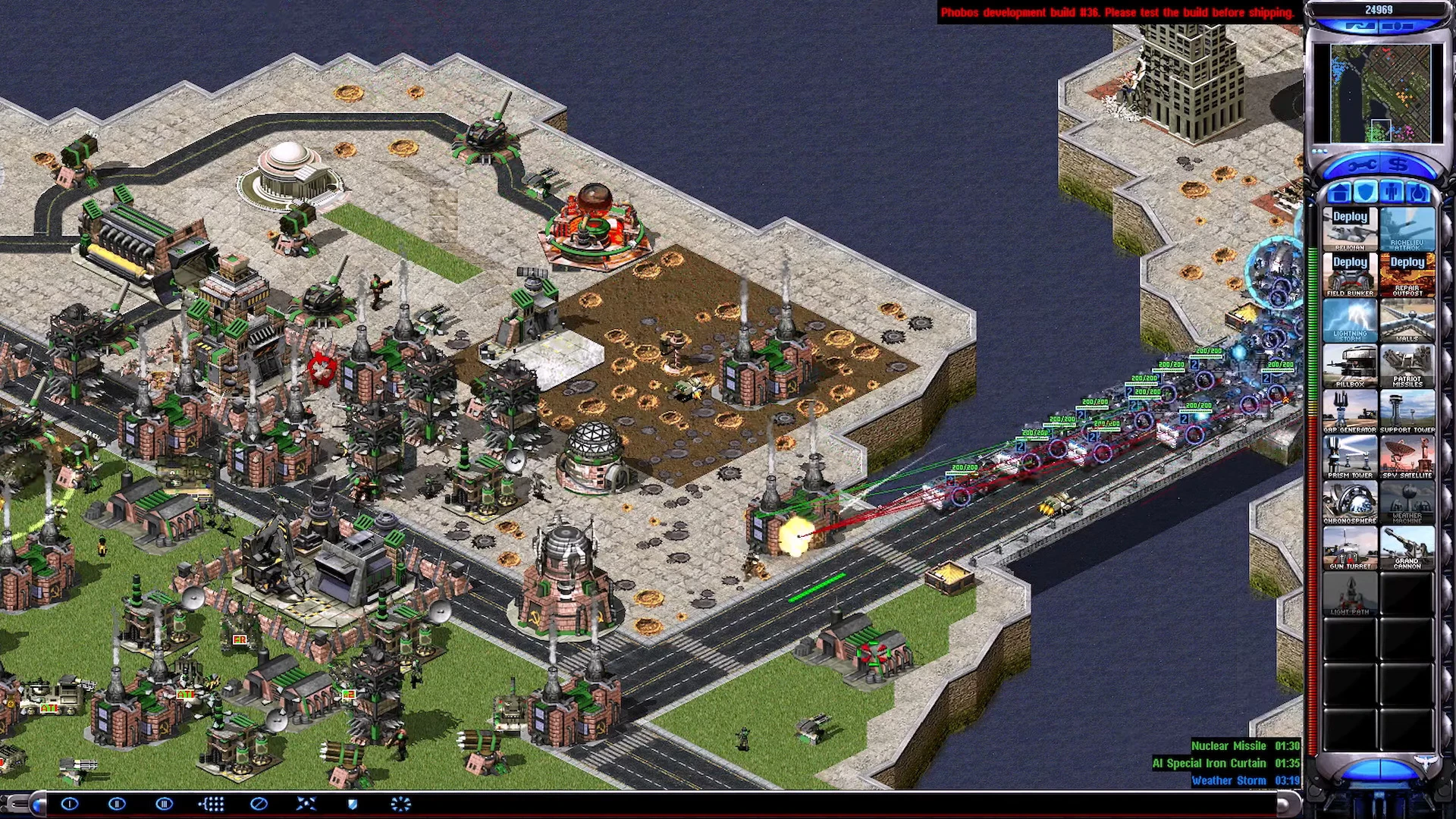
Yuri's Revenge - Red LineCommand & Conquer: Yuri's Revenge (2001)
Yuri's Revenge - Red Line — мод для Yuri's Revenge, в якому представлено понад 17 країн і понад 100 нових юнітів, розподілених між ними. Кожна країна має свій стиль гри та різноманітні війська, що робить протистояння проти ШІ надзвичайно складним.
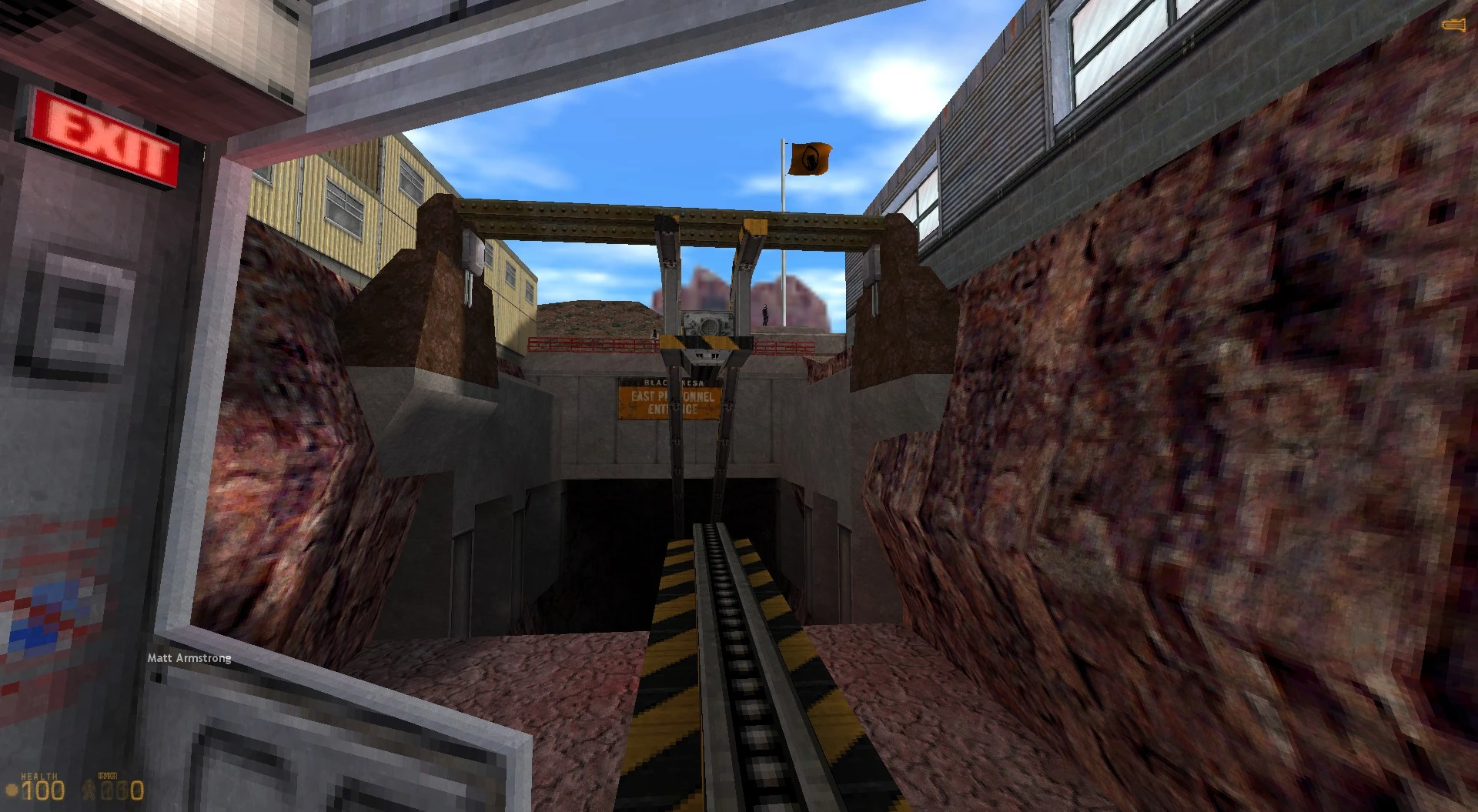
Half-Life Blue Shift: MModHalf-Life (1998)
Half-Life: Blue Shift: MMod - аддон, що дає можливість пройти кампанію Blue Shift із покращеннями та механіками Half-Life: MMod.
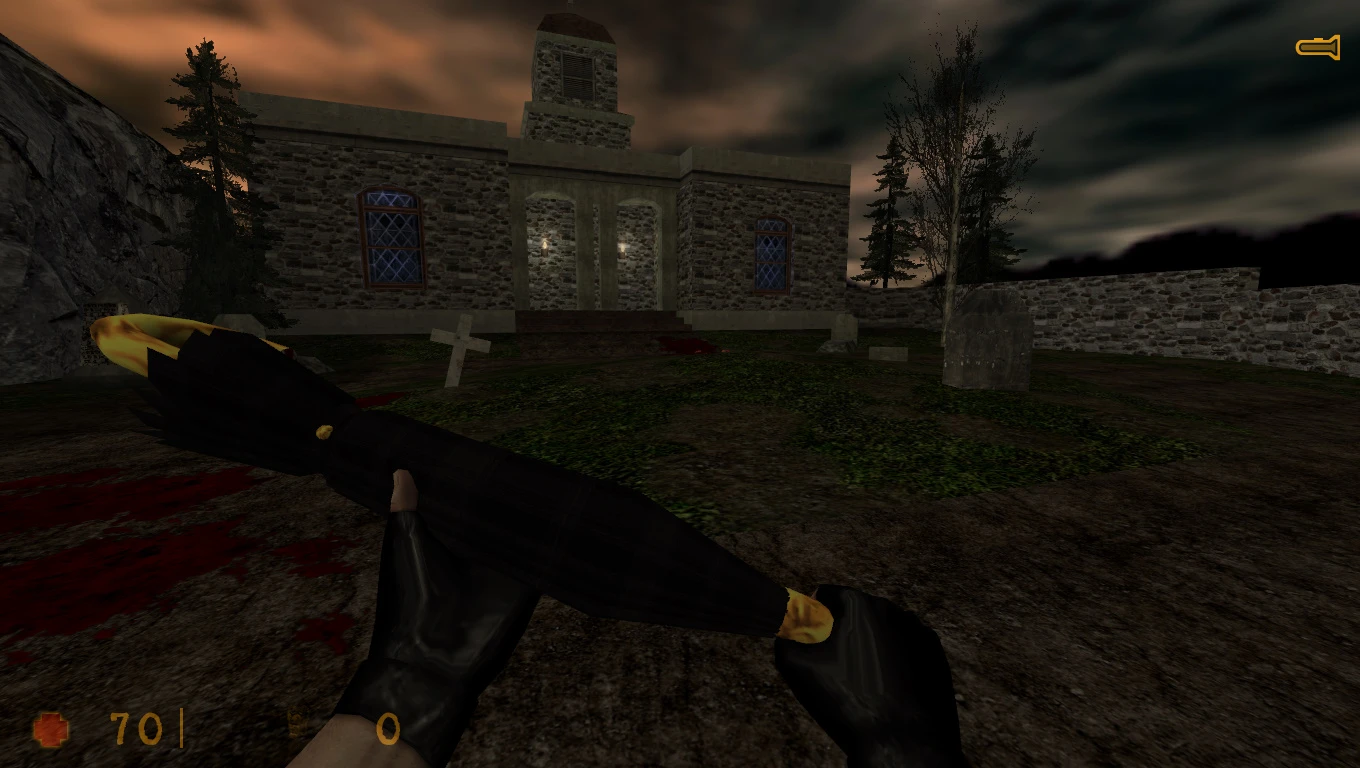
They Hunger XashXT (Unfinished Pre-Alpha)Half-Life (1998)
Модифікована версія They Hunger на основі рушія Xash3D, що містить UD-моделі та якісні текстури, а також багато додаткових мод-паків.
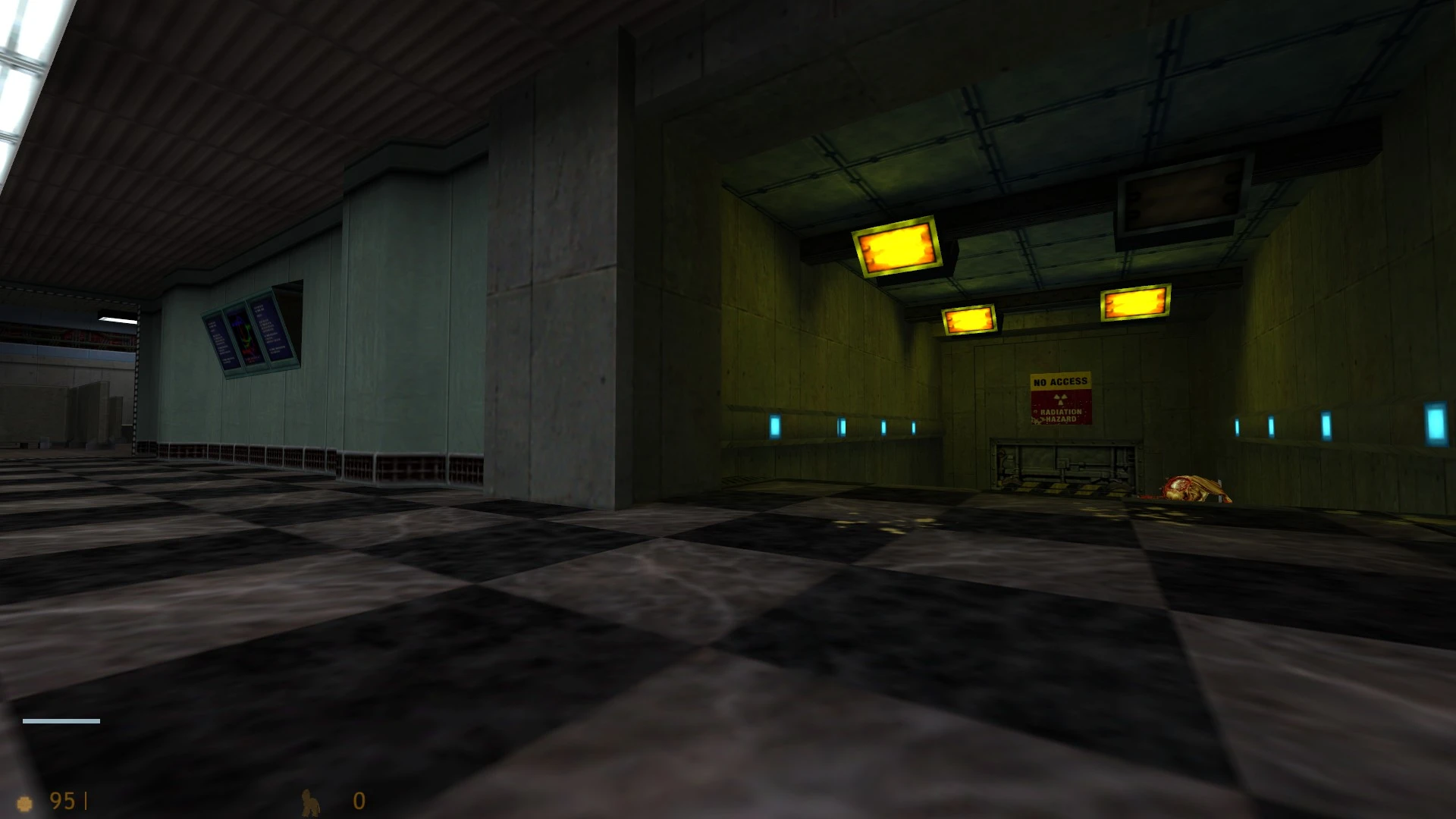
Cat Life: GSHalf-Life (1998)
Cat Life: GS - мод для Half-Life, який дозволяє поглянути на світ гри очима пухнастого героя. Ви граєте за кота XFC-71, відомого як Ньютон, який став об'єктом наукових експериментів. Після інциденту в Black Mesa він опиняється в центрі подій, стикаючись з мутованими істотами та військовими.
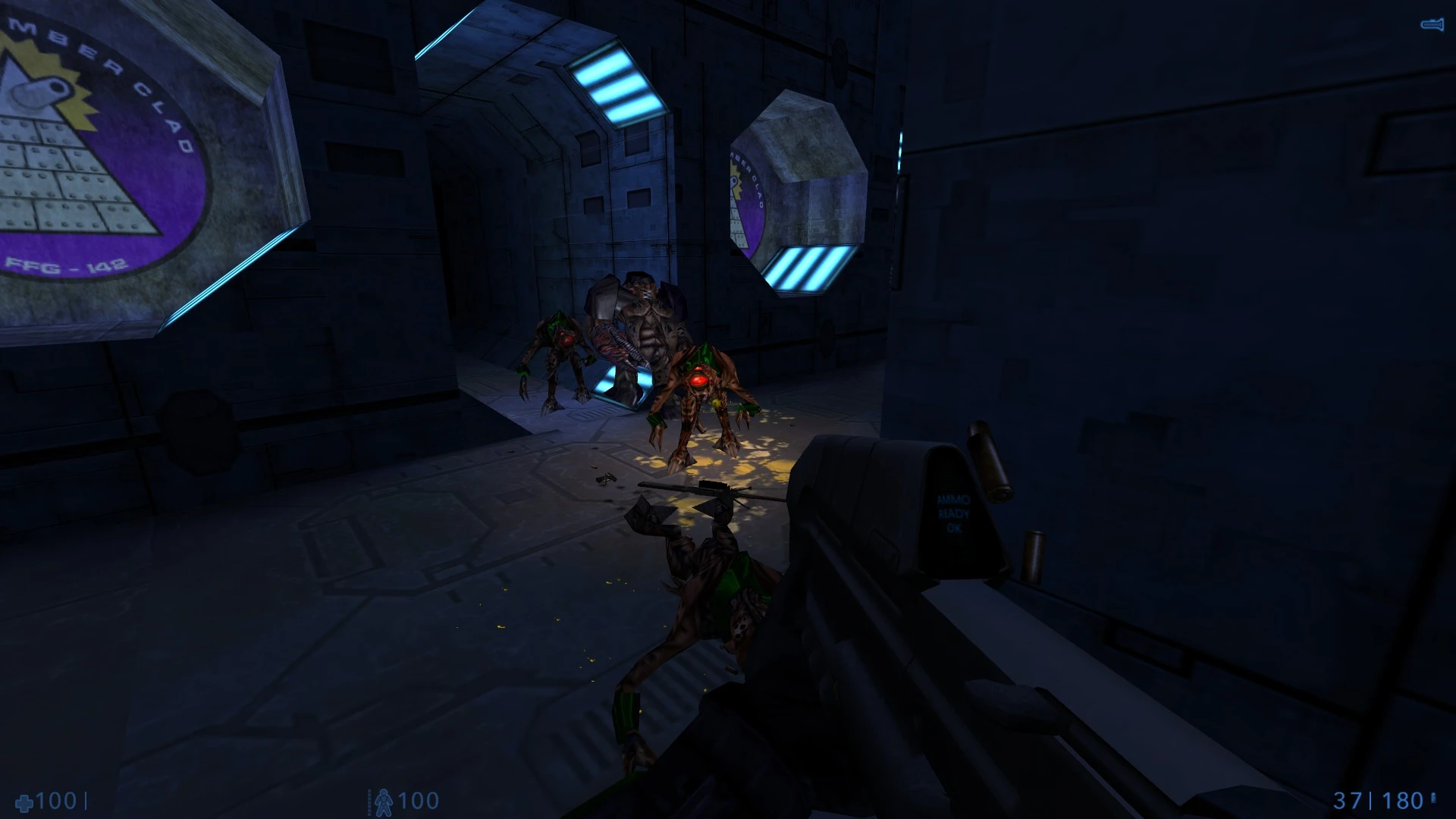
Halo: GoldSourceHalf-Life (1998)
Halo: GoldSource — мод для Half-Life, який відтворює атмосферу та ігровий стиль Halo, включаючи режими Slayer та Firefight, культова зброя та карти оригінального шутера, але працює на рушії GoldSrc.
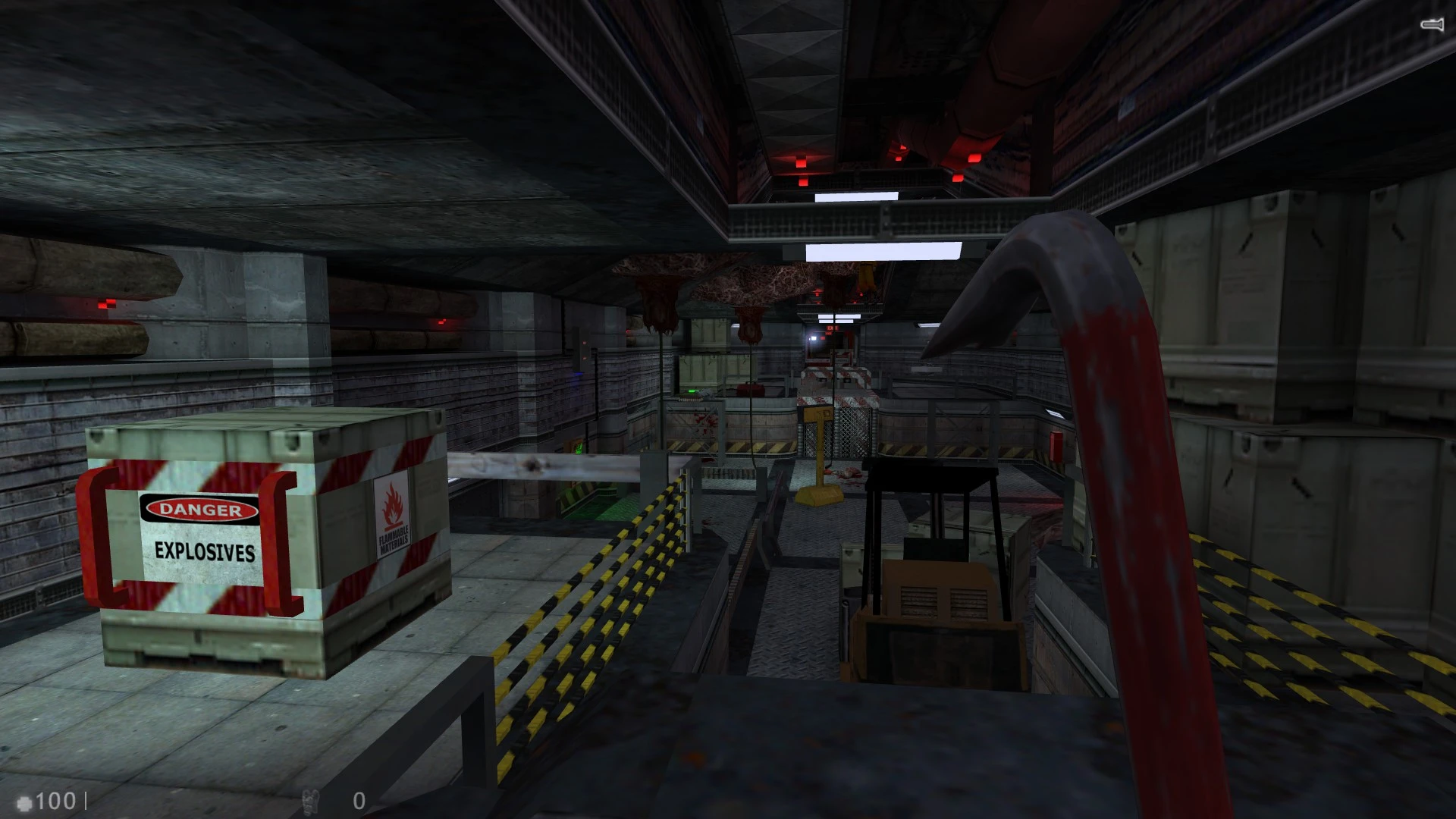
Half-Life: EchoesHalf-Life (1998)
Half-Life: Echoes - це модифікація Half-Life, яка дозволяє поглянути на події оригінальної гри з іншого боку, одночасно покращуючи графіку та анімацію. Ви граєте за вченого з кодовим ім’ям "Суб’єкт № 12", який прибуває до дослідницького комплексу Чорна Меза в день катастрофи. Тепер його головна мета - вижити серед хаосу.
